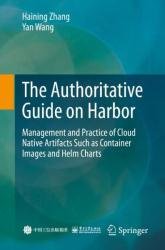The Authoritative Guide on Harbor
- Добавил: literator
- Дата: 21-11-2022, 04:39
- Комментариев: 0
 Название: The Authoritative Guide on Harbor: Management and Practice of Cloud Native Artifacts Such as Container Images and Helm Charts
Название: The Authoritative Guide on Harbor: Management and Practice of Cloud Native Artifacts Such as Container Images and Helm ChartsАвтор: Haining Zhang, Yan Wang
Издательство: Springer, House of Electronics Industry
Год: 2022
Страниц: 327
Язык: английский
Формат: pdf (true)
Размер: 10.2 MB
Harbor is a major Cloud Native Computing Foundation (CNCF) open source project, with thousands of production users all over the world. Authored by its maintainers, The Authoritative Guide on Harbor is the first book about Harbor. This book provides a comprehensive explanation of the open source cloud native registry: Harbor. Written by experts who contributed to and now maintain Harbor, the content covers its architecture, principles, functions, deployment and configuration, scanning artifacts, remote replication, operation and maintenance, customized development, governance, API usage and success stories. Some content of this book is published for the first time, including Harbor’s architecture, the support of OCI artifacts, the design considerations of a highly available registry, the image scanning policy, and the access control of artifacts. This book is an ideal reference for Harbor users and developers.
The term cloud native does not refer to a specific technology but instead is a collection of ideas and technologies, including virtualization, container, microservice, continuous integration and delivery (CI/CD) and DevOps. Among these technologies, the container technology has become the most important fundamental technology in the cloud native field. It has derived a huge ecosystem. Most of other related technologies center around container. For example, Kubernetes is responsible for the container orchestration platform, microservices are implemented relying on containers and DevOps uses containers throughout the process.
When we first came into contact with Docker, we were shocked by its smooth user experience and the excellent container solutions. We deeply felt that this would be a game changer in application development. After doing some research, we found that container images are the lifeblood of Docker. However, there were not many good image management tools at that time. At technical conferences, many users complained about the difficulties in container image management. Therefore, to tackle the pain points of image management, we led a team in VMware R&D China to develop a container image management software. We were dogfooding the software inside the company and achieved some good results. This software became the prototype of Harbor. Harbor was open sourced in 2016 and its popularity far exceeded our expectations. Harbor met the key points of container management and won the favor of a large number of users in China. Harbor’s impact has steadily spread from China to the rest of the world, gaining unanimous recognition from global cloud native community. The number of developers contributing to the Harbor open-source project was increasing day by day.
There are 9 chapters in this book. They are organized as follows:
Chapter 1 introduces the background of cloud native applications, the principles and specifications of artifact management, the role of artifact registry, and the overall architecture of Harbor.
Chapter 2 details the installation and deployment of Harbor, including the key points of high-availability deployment, and also includes the basic operations of Harbor.
Chapter 3 explains the principles of Harbor's access control, as well as related configuration methods.
Chapter 4 analyzes the security policies that can be used in Harbor, including trusted content distribution and vulnerability scanning mechanisms.
Chapter 5 explains the principle of artifact remote replication for images and Helm Charts, as well as the integration with other registry services.
Chapter 6 details Harbor’s advanced management functions, including resource quotas, garbage collection, immutable artifacts, retention policies, and Webhooks.
Chapter 7 explains the life cycle management of Harbor, including steps for backup, recovery, and upgrade.
Chapter 8 sorts out the use of Harbor's API and gives a programming example.
Chapter 9 introduces the governance principles, security release process, and participation methods of the Harbor open-source community.
Intended Audience:
- Software development engineers, test engineers, and operational staff in the cloud native space
- Users, developers, and contributors of the Harbor open-source project
- IT architects and IT technical managers
- University students in Computer Science of related disciplines
Скачать The Authoritative Guide on Harbor
Внимание
Уважаемый посетитель, Вы зашли на сайт как незарегистрированный пользователь.
Мы рекомендуем Вам зарегистрироваться либо войти на сайт под своим именем.
Уважаемый посетитель, Вы зашли на сайт как незарегистрированный пользователь.
Мы рекомендуем Вам зарегистрироваться либо войти на сайт под своим именем.
Информация
Посетители, находящиеся в группе Гости, не могут оставлять комментарии к данной публикации.
Посетители, находящиеся в группе Гости, не могут оставлять комментарии к данной публикации.
